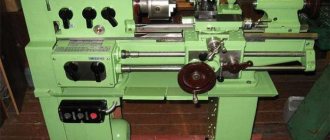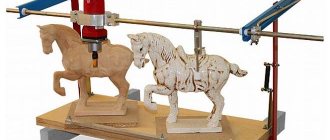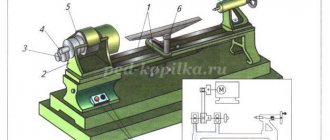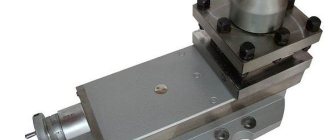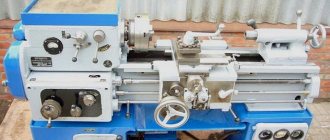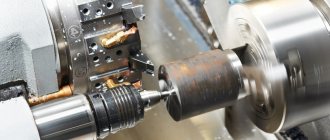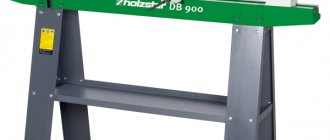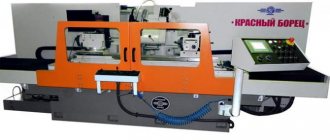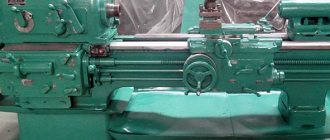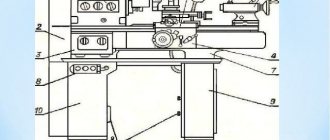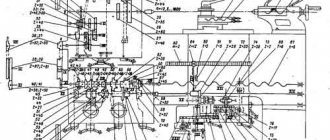The device of a wood cutting machine
Structurally, the machine consists of several main components:
- Bed; made of low-grade steel by casting; vertical posts can be long or short supports. In professional devices that have a gearbox, an additional shaft for uniform movement of the cutter, other devices, long bed posts; the engine and transmission elements are attached to them. In simpler devices, the workpiece is attached to the motor shaft, the frame has short racks. The machine is placed on the table;
- Headstock; on one side, torque from the engine is transmitted to its shaft, on the other, the workpiece is attached; in the simplest case, this is a continuation of the electric motor shaft with a device for fastening the workpiece;
- The tailstock performs several functions: supports, centers the other end of the workpiece; provides fixation of its position depending on the length of the workpiece, movement of the centering cone along the horizontal axis, its rotation (in some cases) together with the workpiece, and locking against untwisting;
- Electric motor; power and speed are selected depending on the weight, size of the workpieces, and machine design; on devices with direct drive, a low-power, low-speed motor is installed;
- The stop for the incisors is a tool rest; copier
DIY making
A simple model of a lathe with a copier is made on the basis of a drill. To construct a wood turning and copying machine with your own hands, you need the following tools and components:
- manual frezer;
- welding machine;
- metal sheets;
- corners;
- fasteners (bolts, nails and screws);
- thrust bars;
- headstock and headstock;
- power unit;
- cutter stop.
The machine is manufactured in several stages:
- Drawing development. It will be used to assemble the elements of the woodworking device. Most often, a ready-made drawing of turning equipment is taken and modified depending on the features of the copier.
- Creation of a bed. It is necessary to connect metal sheets and corners using a welding machine. It is important that the homemade frame is resistant to physical impacts and vibrations.
- Installation of an electric motor. For processing small products, it is recommended to use a motor with a power of up to 250 W. It is important to protect the engine from environmental influences.
- Fastening the faceplate. It must be secured to the drive wheel of the electric motor.
After installing the main parts of the turning equipment, you can proceed to creating a copier.
Creating a copier
In the process of making a homemade copier for a wood lathe, the following rules must be taken into account:
- Requires a hand router. To install it, you need to make a surface from plywood.
- In the area where the copier will be located, you need to make several holes and attach horizontal bars to it.
- In order for processing to be carried out along the entire length of the workpiece, it is necessary to ensure the movement of the platform along the entire bed.
- It is recommended to use a level during installation work. It is important that the bars do not deviate from the horizontal position. Otherwise, errors may occur when processing parts.
After creating the copier, you need to attach the template to the block using self-tapping screws. It is important that the copier can be moved away or completely dismantled. In this case, the mill can be used for standard turning operations.
After installation work, it is recommended to test the lathe by processing a test part. During turning, safety precautions must be observed. You cannot press yourself against the lathe or lean on it. The master must work in protective glasses and special clothing.
Manufacturing sequence
To make the machine reliable, convenient, and durable, adhere to the following plan:
- Find out which workpieces need to be turned: length, diameter, material, shape features, quantity; this information determines the choice of product components: their dimensions, strength, design features;
- Determine the type of drive: direct, with a belt drive, with a gear transmission; choose a design option: floor-standing, table-top device;
- They find out what materials and parts are available, what can be used from old, unnecessary mechanisms, and what needs to be purchased;
- Draw sketches of individual parts and assemblies indicating dimensions;
- A frame is welded from sections of angles and channels; the simplest option is a desktop machine with direct drive;
- Install the engine; on its shaft there is a device for centering and fastening one end of the workpiece;
- The tailstock is made and installed on the bed;
- They weld the tool rest, cut out the copier, and fasten them near the bed;
- The device is tested and modified if necessary.
Classic machine design
The machines are equipped with a sophisticated design system. These include CNC models that operate in an automated mode. Such devices are obtained by using drawings and a copying device. The classic design consists of five nodes:
- The main element is a metal frame; individual parts are connected by welding. The bed has different heights, so when creating a homemade machine, this particular parameter is selected.
- The front and tailstock are needed to store the box, drive and electric motor. The rear one fixes the workpiece to obtain dimensional parts.
- An electric motor and drive rotate the workpiece.
- A tool rest is needed for the best quality work. The cut site is protected to prevent injury.
- The master and slave centers secure the part.
A homemade lathe-copier for wood makes it possible to carry out high-quality cutting of workpieces no worse than production models.
Tools, actions with them
They begin work by marking the sections of the corner and channel for the frame; To do this, use a tape measure or marker; for drawing perpendicular cutting lines - a square. Using a grinder, cut parts to the required length.
An abrasive wheel is used to remove rust and dirt from the surface of parts along the joints to improve the quality of the weld.
- On the welding table, the workpieces are placed in the required configuration, the value of the right angle is controlled, and they are pressed to the surface with clamps.
- Boil the joint on both sides and repeat the operation for all joints. Use a grinder with an abrasive stone to clean and level the weld seams.
- On the finished frame, markings are made for mounting the engine, and with a punch, recesses are made in the place of future holes.
Using a drill, holes are drilled first with a drill of small diameter (3-4 mm), then with a large one (9-10 mm). The tool rest is made with the same tools. To manufacture some parts of the headstock and tailstock, a metal lathe is required.
It’s easier to order a shaft, thrust cone, and bearing housings from a professional turner. You can simplify the tailstock to the limit: use a long screw with a conical point.
The copier is made from plywood. A marker is used to mark the profile line of the future product, and a cut is made along it with a jigsaw.
- The copier is mounted at the level of the tool rest. A limiter is installed on the turning cutter, moving along the edge of the copier.
- Wooden pulleys for a drive with a belt drive are made like this: a disk of the required diameter is cut out of a hardwood board and placed on the motor shaft.
A temporary tool is prepared, the engine is secured, started, and a pulley is machined on it. It will be accurate and balanced.
Classification of lathes
Many people decide to buy and install lathes in their own workshop because of their possible use in the manufacture of cylindrical products. There are quite a large number of different models; they can be divided into several groups:
- Classic equipment, when the workpiece is located in a chuck or faceplate. A cutter is used as a cutting tool. The workpiece can rotate at different speeds. However, the equipment is not suitable for mass production.
- Copying machines can be used to work from a template. By using a template, you can simplify the task of manufacturing similar products. For small-scale production, a manually operated machine is suitable, as it is low cost and easy to use.
- Milling machines are extremely common today. This is due to the fact that they are widely used in the production of cabinet and flat parts made of wood and metal. There is also a wood turning and milling machine, which can be used to perform various operations.
- Models with numerical control. In mass production or the manufacture of expensive products, equipment that has a CNC unit can be used. However, the use of a copier significantly reduces the cost of the product.
The copying device for a wood lathe has very attractive characteristics, due to which they began to be installed in private and other workshops.
Mini wood cutting machine
This device is useful for creative work, creating complex products from small round parts. One of the common options is a machine made from a drill.
Attach the drill to the base; instead of a drill, insert a rod with a plan washer into the chuck. The tailstock is a long pointed screw.
Motors from old household appliances are often used to drive a mini-machine:
- Washing machine, reel-to-reel tape recorder;
- DC motors from a car heater and windshield wiper drive are suitable.
This device is successfully used in everyday life for polishing the surface of parts after repairs, removing old coatings, and applying varnish.
Purpose and characteristics
Equipment for wood turning operations has reduced power and weight compared to metalworking devices, but has no less functionality.
Woodworking lathes offered by Stankoff.RU are used both in small home workshops and in large enterprises that require turned wood elements for the manufacture of products. The need to buy a wood lathe from our catalog comes from craftsmen whose activities involve creating parts for the production of carpentry, furniture, decorative finishing elements and souvenirs. The workpiece is usually cylindrical parts or timber with smoothed corners. During the rotational movement of the workpiece and the translational feed of the cutting tool, the material is processed using one of the main operations:
- longitudinal, axial or frontal trimming and turning of workpieces;
- drilling holes and shaped profile boring;
- production of openings and grooves;
- thread cutting;
- processing the end parts of parts, rounding corners;
- surface grinding.
Depending on the modification and technological equipment, wood lathes are used to manufacture parts of complex configurations or are used to create simple household utensils, decoration elements and souvenirs. Processing makes it possible to produce products of symmetrical cylindrical or conical shape using turning of the outer and inner surfaces of the element. Tabletop wood lathes differ from floor-standing models in several ways and have:
- lower power levels and electric motor speeds;
- limited by the maximum dimensions of the workpiece being processed;
- simplified method of switching rotation speed;
- limited range of additional accessories.
Design and operating principle of turning equipment
The stable base of the wood lathe is mounted on a cast iron bed, which ensures stability during operation by compensating for vibrations produced by the device. The headstock and tailstock racks are attached to the frame, and the caliper and electric motor are located. In models with electric drive, the motor is covered by an aluminum casing. The equipment mechanisms are not subject to overheating, so the machine does not have a coolant supply system.
A working head with a special device for fixing the cutting tool is installed on the headstock. The spindle is connected to a drive pulley, which transmits the motion energy from the electric motor. Replaceable faceplates for fixing the workpiece have different sizes to allow you to work with parts of different diameters. Before fixing the workpiece on the spindle, the holes necessary for fixing the part are drilled at the ends of the blank. This helps make the shaft rotate more evenly.
If desired, a lathe for woodworking can be equipped with a number of additional devices that can significantly expand the capabilities of the equipment when working with wood:
- sets of cutters, chucks and adapters;
- copier;
- equipped with a variable speed transmission for smooth speed control;
- a set of supports to prevent deflection of the workpieces.
Photo of a wood lathe
Safety precautions when working with a turning and copying machine
Following the advice of experts when working with a copying lathe will make it possible to avoid numerous unpleasant situations and damage:
- Always check the fastening of elements and protective parts.
- It is necessary to remove unnecessary objects from the machine.
- Tools must be in their place.
- The cutting tool is checked for correct sharpness and proper design.
- The feeding of the equipment is carried out smoothly and without pressure, only after reaching the full rotation speed.
If any malfunctions occur, it is recommended to contact a specialist or carefully inspect all components.
A variety of equipment, including machines, can be used to work with wood. Through the use of such equipment, it accelerates the process of mechanical processing of wooden blanks. A wood lathe with a copier is in great demand, which greatly simplifies the execution of tasks: making furniture legs, door handles and balusters.
Classic design
Industrial machines have a rather complex design, especially CNC versions, which can carry out processing automatically. The required product can also be obtained using copying equipment. The classic design is represented by a combination of the following main components:
- The bed acts as a base and connecting element. The structure is made using metal, the individual elements are connected by welding. The bed can have different heights. Each craftsman chooses his own height when making a homemade structure.
- The headstock and tailstock are also an integral part of the machine. The headstock is used to house the gearbox and drive, as well as the electric motor. The tailstock is used to fix the workpiece, which makes it possible to produce longer products.
- The main rotation is received by the workpiece. It is transmitted from an electric motor through a drive.
- The tool rest also allows for high-quality processing. It is worth securing the cutting area to eliminate the possibility of injury to your hands or contact with a foreign element.
- Leading and driven centers used to secure the workpiece.
A homemade copier for a wood lathe also allows for high-quality processing of workpieces.
DIY making
Industrial versions of machines are expensive. That is why many are considering the possibility of assembling the machine with their own hands. Recommendations for carrying out the work are as follows:
- First, you should develop or download a drawing according to which the assembly will be carried out. As a rule, a drawing of a conventional lathe is taken, which is modified to accommodate the installation of a copier.
- Work begins with the creation of the bed. This will require corners, as well as sheets of metal. The connection of individual elements is carried out using a welding machine. It is worth considering that screw connections are characterized by less rigidity. The bed must be strong and resistant to vibration.
- The main component is the electric motor. In order to increase the functionality of the equipment, an electric motor with a power of 200-250 W at 1500 rpm is installed. If you plan to process large workpieces, then a more powerful motor is installed. The motor should be protected from environmental influences.
- To fix the workpiece, a faceplate is attached to the output shaft. It has several sharp elements that it hits. Due to the sharp elements, rotation is transmitted, but fixation is carried out due to the tailstock with centers.
Most attention is paid to the production of the copier. This is what distinguishes a lathe from a copying machine.
Creating a copier
The copier is used to produce similar products. Due to its use, the productivity indicator is significantly increased. Among the features associated with creating a copier, the following points are noted:
Turning using a copier
When processing shaped surfaces using the copying method, special copying devices are used, which are installed on the machine bed and connected to the machine support using a copying roller. The main movement of the support is movement along the spindle axis, while in the transverse direction the movement of the cutter copies the surface of the copier. Processing accuracy 0.05...0.1mm. The caliper can be moved either manually or using mechanical feed. Copier processing requires highly skilled workers, and the method is low-productivity.
More accurate and productive processing using copiers allows you to obtain special hydrocopying machines. In them, the copy roller and caliper are moved using hydraulic cylinders controlled by a special spool system. The longitudinal feed of the tool is carried out from the gearbox, and the transverse feed is carried out using a hydraulic drive. When using copiers, as a rule, you have to assign 1 machine to each operation, because their readjustment is very difficult. Therefore, hydrocopiers are used in large-scale and batch production. Hydrocopiers are used on both turning and milling machines, as well as on aggregate machines.
Currently, in small-scale and mass production, CNC machines are widely used for processing shaped surfaces with standard tools. In this case, the specified surface profile is specified by the coordinates of the reference points in the control program. To obtain intermediate geometric information between control points, various interpolation methods are used. A given profile can be obtained on machines with a contour or combined control system. The accuracy of processing on CNC machines depends on many factors, the main ones being: the selected technological processing scheme, as well as the approximation error of the machine control system.
When processing shaped surfaces using the copying method, special copying devices are used, which are installed on the machine bed and connected to the machine support using a copying roller. The main movement of the support is movement along the spindle axis, while in the transverse direction the movement of the cutter copies the surface of the copier. Processing accuracy 0.05...0.1mm. The caliper can be moved either manually or using mechanical feed. Copier processing requires highly skilled workers, and the method is low-productivity.
More accurate and productive processing using copiers allows you to obtain special hydrocopying machines. In them, the copy roller and caliper are moved using hydraulic cylinders controlled by a special spool system. The longitudinal feed of the tool is carried out from the gearbox, and the transverse feed is carried out using a hydraulic drive. When using copiers, as a rule, you have to assign 1 machine to each operation, because their readjustment is very difficult. Therefore, hydrocopiers are used in large-scale and batch production. Hydrocopiers are used on both turning and milling machines, as well as on aggregate machines.
Currently, in small-scale and mass production, CNC machines are widely used for processing shaped surfaces with standard tools. In this case, the specified surface profile is specified by the coordinates of the reference points in the control program. To obtain intermediate geometric information between control points, various interpolation methods are used. A given profile can be obtained on machines with a contour or combined control system. The accuracy of processing on CNC machines depends on many factors, the main ones being: the selected technological processing scheme, as well as the approximation error of the machine control system.
